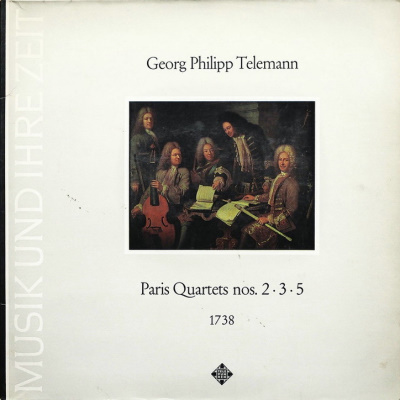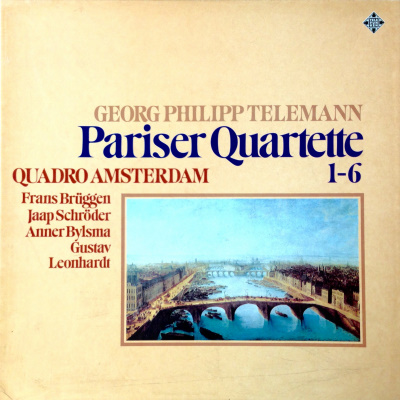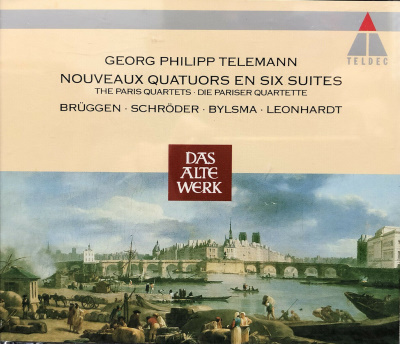 |
|
1 LP -
SAWT 9523-A - (p) 1968
|
 |
| 2 LPs -
6.35065 DX (TK 11565/1-2) - (p) 1974 |
 |
| 2 CDs -
4509-92177-2 - (c) 1993 |
|
PARISER
QUARTETTE 2 · 3 · 5
"Nouveaux Quatuors en Six suites à
une flûte traversière, un violon, une
basse de viole ou violoncelle et basse
continue", Paris 1738
|
|
|
|
|
|
|
|
| Georg Philipp
TELEMANN (1681-1767) |
Quartett
Nr. 2 a-moll |
|
17' 29" |
|
|
-
Allègrement
|
2' 46" |
|
A1
|
|
- Flatteusement
|
3' 18" |
|
A2
|
|
-
Légèrement
|
2' 14" |
|
A3 |
|
- Un
peu vivement
|
3' 10" |
|
A4
|
|
-
Vite |
1' 49" |
|
A5 |
|
-
Coulant
|
4' 46" |
|
A6 |
|
Quartett
Nr. 3 G-dur |
|
18' 11" |
|
|
-
Prélude (un peu vivement)
|
2' 02" |
|
A7 |
|
-
Légèrement |
3' 05" |
|
A8 |
|
-
Gracieusement |
2' 10" |
|
A9 |
|
-
Vite |
2' 45" |
|
A10 |
|
-
Modéré |
2' 57" |
|
B1 |
|
- Gai |
1' 52" |
|
B2 |
|
-
Lentement-Vite-Lentement-Vite |
4' 08" |
|
B3 |
|
Quartett
Nr. 5 A-dur |
|
16' 47" |
|
|
-
Prélude (Vivement)
|
2' 11" |
|
B4 |
|
- Gai |
2' 06" |
|
B5 |
|
-
Modéré |
4' 44" |
|
B6 |
|
-
Modéré |
3' 35" |
|
B7 |
|
- Pas
vite
|
2' 10" |
|
B8 |
|
- Un
peu gai |
2' 35" |
|
B9 |
|
|
|
|
|
QUADRO AMSTERDAM
- Frans Brüggen, Querflöte
(Richard Hammig, Marktneukirchen 1958)
- Jaap Schröder, Violine (Straduvarius,
Cremona 1709)
- Anner Bzlsma, Violoncello (Johannes
Franciscus Pressenda, Turin 1835)
- Gustav Leonhardt, Cembalo (Rainer
Schütze, Heidelberg 1963 nach am
Hollandische original c.1700)
|
|
|
|
|
|
Luogo
e data di registrazione |
|
Bennebroek (The
Netherland) - 29 Maggio / 1 Giugno
1967
|
|
|
Registrazione: live
/ studio |
|
studio |
|
|
Producer |
|
Wolf Erichson
|
|
|
Prima Edizione LP |
|
Telefunken "Das Alte
Werk" | SAWT 9523-A | 1 LP -
durata 52' 27" | (p) 1968 | ANA
Telefunken
| 6.35065 DX (TK 11565/1-2 | 2
LPs - durata 51' 33" - 52' 27" |
(p) 1974 | ANA | Riedizione
|
|
|
Edizione CD |
|
Warner Classics |
LC 6019 | 4509-92177-2 | 2 CDs -
durata 71' 36" - 73' 01" | (c)
1993 | ADD |
|
|
Cover
|
|
Robert Tourniüres
"The Chamber Music Trio".
|
|
|
Note |
|
-
|
|
|
|
|
Among the
"several printed works" to
which people in Paris had
already taken a liking
before Telemann's arrival
were certainly the six Quadri
(c. 1730), which the Paris
publisher Le Clerc had later
brought out in 1736 as Six
Quatuors. As the
pattern of a new practical
marriage between chamber
music and concerto they must
have caused a considerable
stir in Paris. In their
combination of the solidity
and refinement of chamber
music with the brilliance of
the concerto they appealed
directly to the musical
taste of the Paris salons,
which inclined towards the
subtle as well as the
illustrative; and as the
epitome of fashionable
Italian instrumental forms
(concerti, chamber- and
church-sonatas) they exactly
fitted in with the
predilection for everything
Italian which had been a
sign of good form in Paris
since the twenties. Into
this well-prepared scene
Telemann - with in his hand
the Privilège du Roi to
assure his success - in 1738
threw his Nouveaux
Quatuors, which
combined the charm of the
new marriage with a
courteous bow to his hosts
and their national musical
‘goût’; for not only is the
designation of the movements
French, but their sequence
and forms also embrace the
traditions of French chamber
music, in that loose fusion
of German, French and
Italian elements which, for
the mature Telemann, had
more and more clearly become
the central tenet of his
instrumental music. Small
wonder, then, that the four
named soloists extolled by
the composer succumbed just
as much to the clearly
‘calculated’ effect of this
music as did the general
public, whose sympathy is
reflected even in the
astonishing subscription
list for the first edition.
Small wonder too since the
‘Paris Quartets‘, beyond all
these calculated charms and
beyond the partiality of
their historical period, are
also important chamber
music: music with an aim,
admittedly, and as such: a
model of 18th-century social
art, but also a kind of
music whose wealth of
inspiration, elegance and
musical ‘wit’ is matched by
little from the first half
of this century.
The characteristic fusion of
‘national styles’ of music
in a markedly individual
idiom and the extraordinary
wealth of invention of the
“Paris Quartets‘ are clearly
shown in the A minor work.
The first movement is a
completely Italian concerto
allegro for flute and
accompanying "orchestra";
the second a dance movement
without a concertante solo,
uniting the elements of
Minuet and Polonaise to form
a ‘flattering’ character
piece full of tender
sensuality of sound. It is
followed by a French Gigue,
a quasi-Passepied whidt
again is laid out more in
grouped solo parts, and a
very fast ‘character piece‘
scurrying along with witty
chromatic surprises. The
Finale, as is common in the
Paris Quartets, is e
particularly impressive
movement, an expansive
Gavotte whose episodes relax
the movement into fewer
voices, give on the
expression a surprisingly
serious tone through
harmonic intensification und
melodic sighs, and thus
stress the tendency of all
these pieces - from dance
movements to ‘character
pieces‘, still only in
stylised dance forms -
towards sensitive and
elegant expressive
miniatures.
The ‘reunion des goûts' is
revealed in the third
quartet in a different way
from that of the second, and
it is the only one of the
series to have seven
movements, not six. The
Prélude, in a loosely
'limbering-up’ series of
fugal and concerted
sections, hints at French
inflections and makes use
chiefly of flute and violin
as solo instruments in the
concerto style. The second
movement begins as a very
lively Bourrée, but in its
minor middle section, where
the concerto element is much
broader and also more
exactingly planned, it
becomes surprisingly
serious. A wholly French
Rondeau, with a captivating,
graceful dance-tune and full
ensemble sonority,
constitutes the third
movement. The main part of
the following movement is a
quasi-Gigue, but with a
wittily irregular structure
and little echoes,
especially from the flute,
which evoke hunting
associations: the E minor
central section, on other
hand, unites the Gigue
rhythm with chains of
suspensions, which evoke a
characteristically veiled,
muted mood. Very similarly,
the next movement too is a
modified ‘character piece’
and draws on Telemann’s
favourite Polonaise manner,
while the little piece
marked "Gai" does full
justice to its title with
its turbulent motion and
strikingly impressive
melody, rhythmic finesse and
virtuosic loosening of the
previously compact movement
in the middle section. The
Finale is once again
practically the weightiest
movement of the quartet: it
is almost a French overture,
with a ceremonially solemn
slow introduction and a
quick fugato, both of which
are repeated and thus
substantially expanded in
size, while the expression
is intensified and the
thematic material varied -
but all this is bound up
into the traditional binary
structure of a suite
movement.
The fifth quartet again
takes a different course.
The Prélude thus starts of
as a four-part fugue, moves
to a free concerted passage
for the instrumental voices,
turns for a few bars into a
flute concerto, and finally
mixes fugato and flute
‘solo’ until, with a
vigorous orchestral cadence,
the movement is rounded all
in the best Italian ‘goût’.
Next comes a comparably
simple little dance movement
in 3/8 time; but it, in
turn, is followed by another
of those elaborated
'character' pieces which are
still only vaguely
reminiscent of traditional
dance types, and, as the
fourth movement, by an even
more emphatically
'characteristic' piece,
whose bucolic tone it, in
the A minor middle section,
distinctly tinged with
melancholy. The fifth
movement is once more a
Rondeau, bubbling over with
beauties of colour, rhythm
and melody, even although
the gracefully popular
refrain of the flute is
strangely muted in the
general texture. The Finale
once again combines what in
these quartets lie closest
to Telemann's heart: French
and Italian (and not least,
German) inflections,
dance-movement forms and
types, compact sonority and
soloistic individuality,
concertante playing and
chamber-music style.
Ludwig
Finscher
(translated
by Lionel Salter)
|
  |
|
|